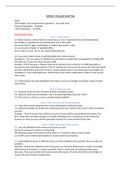Summary
Summary Solicitor's Accounts 86% distinction notes
- Module
- Solicitors Accounts
- Institution
- University Of Law (ULaw)
These notes provide everything you need to revise for the solicitor's accounts exam and to take into the exam with you (open book University of Law). These notes include: SRA accounts rules, examples financial statement, examples client ledger questions (for a will and for sale and purchase of a ...
[Show more]



